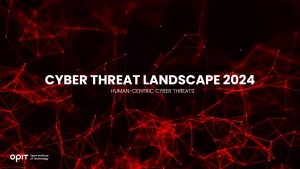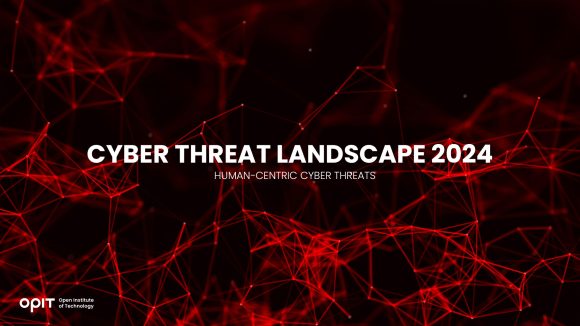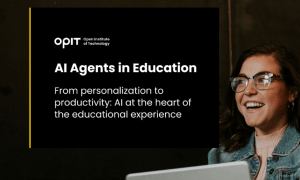

Human-centric cyber threats have long posed a serious issue for organizations. After all, humans are often the weakest link in the cybersecurity chain. Unfortunately, when artificial intelligence came into the mix, it only made these threats even more dangerous.
So, what can be done about these cyber threats now?
That’s precisely what we asked Tom Vazdar, the chair of the Enterprise Cybersecurity Master’s program at the Open Institute of Technology (OPIT), and Venicia Solomons, aka the “Cyber Queen.”
They dedicated a significant portion of their “Cyber Threat Landscape 2024: Navigating New Risks” master class to AI-powered human-centric cyber threats. So, let’s see what these two experts have to say on the topic.
Human-Centric Cyber Threats 101
Before exploring how AI impacted human-centric cyber threats, let’s go back to the basics. What are human-centric cyber threats?
As you might conclude from the name, human-centric cyber threats are cybersecurity risks that exploit human behavior or vulnerabilities (e.g., fear). Even if you haven’t heard of the term “human-centric cyber threats,” you’ve probably heard of (or even experienced) the threats themselves.
The most common of these threats are phishing attacks, which rely on deceptive emails to trick users into revealing confidential information (or clicking on malicious links). The result? Stolen credentials, ransomware infections, and general IT chaos.
How Has AI Impacted Human-Centric Cyber Threats?
AI has infiltrated virtually every cybersecurity sector. Social engineering is no different.
As mentioned, AI has made human-centric cyber threats substantially more dangerous. How? By making them difficult to spot.
In Venicia’s words, AI has allowed “a more personalized and convincing social engineering attack.”
In terms of email phishing, malicious actors use AI to write “beautifully crafted emails,” as Tom puts it. These emails contain no grammatical errors and can mimic the sender’s writing style, making them appear more legitimate and harder to identify as fraudulent.
These highly targeted AI-powered phishing emails are no longer considered “regular” phishing attacks but spear phishing emails, which are significantly more likely to fool their targets.
Unfortunately, it doesn’t stop there.
As AI technology advances, its capabilities go far beyond crafting a simple email. Venicia warns that AI-powered voice technology can even create convincing voice messages or phone calls that sound exactly like a trusted individual, such as a colleague, supervisor, or even the CEO of the company. Obey the instructions from these phone calls, and you’ll likely put your organization in harm’s way.
How to Counter AI-Powered Human-Centric Cyber Threats
Given how advanced human-centric cyber threats have gotten, one logical question arises – how can organizations counter them? Luckily, there are several ways to do this. Some rely on technology to detect and mitigate threats. However, most of them strive to correct what caused the issue in the first place – human behavior.
Enhancing Email Security Measures
The first step in countering the most common human-centric cyber threats is a given for everyone, from individuals to organizations. You must enhance your email security measures.
Tom provides a brief overview of how you can do this.
No. 1 – you need a reliable filtering solution. For Gmail users, there’s already one such solution in place.
No. 2 – organizations should take full advantage of phishing filters. Before, only spam filters existed, so this is a major upgrade in email security.
And No. 3 – you should consider implementing DMARC (Domain-based Message Authentication, Reporting, and Conformance) to prevent email spoofing and phishing attacks.
Keeping Up With System Updates
Another “technical” move you can make to counter AI-powered human-centric cyber threats is to ensure all your systems are regularly updated. Fail to keep up with software updates and patches, and you’re looking at a strong possibility of facing zero-day attacks. Zero-day attacks are particularly dangerous because they exploit vulnerabilities that are unknown to the software vendor, making them difficult to defend against.
Top of Form
Nurturing a Culture of Skepticism
The key component of the human-centric cyber threats is, in fact, humans. That’s why they should also be the key component in countering these threats.
At an organizational level, numerous steps are needed to minimize the risks of employees falling for these threats. But it all starts with what Tom refers to as a “culture of skepticism.”
Employees should constantly be suspicious of any unsolicited emails, messages, or requests for sensitive information.
They should always ask themselves – who is sending this, and why are they doing so?
This is especially important if the correspondence comes from a seemingly trusted source. As Tom puts it, “Don’t click immediately on a link that somebody sent you because you are familiar with the name.” He labels this as the “Rule No. 1” of cybersecurity awareness.
Growing the Cybersecurity Culture
The ultra-specific culture of skepticism will help create a more security-conscious workforce. But it’s far from enough to make a fundamental change in how employees perceive (and respond to) threats. For that, you need a strong cybersecurity culture.
Tom links this culture to the corporate culture. The organization’s mission, vision, statement of purpose, and values that shape the corporate culture should also be applicable to cybersecurity. Of course, this isn’t something companies can do overnight. They must grow and nurture this culture if they are to see any meaningful results.
According to Tom, it will probably take at least 18 months before these results start to show.
During this time, organizations must work on strengthening the relationships between every department, focusing on the human resources and security sectors. These two sectors should be the ones to primarily grow the cybersecurity culture within the company, as they’re well versed in the two pillars of this culture – human behavior and cybersecurity.
However, this strong interdepartmental relationship is important for another reason.
As Tom puts it, “[As humans], we cannot do anything by ourselves. But as a collective, with the help within the organization, we can.”
Staying Educated
The world of AI and cybersecurity have one thing in common – they never sleep. The only way to keep up with these ever-evolving worlds is to stay educated.
The best practice would be to gain a solid base by completing a comprehensive program, such as OPIT’s Enterprise Cybersecurity Master’s program. Then, it’s all about continuously learning about new developments, trends, and threats in AI and cybersecurity.
Conducting Regular Training
For most people, it’s not enough to just explain how human-centric cyber threats work. They must see them in action. Especially since many people believe that phishing attacks won’t happen to them or, if they do, they simply won’t fall for them. Unfortunately, neither of these are true.
Approximately 3.4 billion phishing emails are sent each day, and millions of them successfully bypass all email authentication methods. With such high figures, developing critical thinking among the employees is the No. 1 priority. After all, humans are the first line of defense against cyber threats.
But humans must be properly trained to counter these cyber threats. This training includes the organization’s security department sending fake phishing emails to employees to test their vigilance. Venicia calls employees who fall for these emails “clickers” and adds that no one wants to be a clicker. So, they do everything in their power to avoid falling for similar attacks in the future.
However, the key to successful employee training in this area also involves avoiding sending similar fake emails. If the company keeps trying to trick the employees in the same way, they’ll likely become desensitized and less likely to take real threats seriously.
So, Tom proposes including gamification in the training. This way, the training can be more engaging and interactive, encouraging employees to actively participate and learn. Interestingly, AI can be a powerful ally here, helping create realistic scenarios and personalized learning experiences based on employee responses.
Following in the Competitors’ Footsteps
When it comes to cybersecurity, it’s crucial to be proactive rather than reactive. Even if an organization hasn’t had issues with cyberattacks, it doesn’t mean it will stay this way. So, the best course of action is to monitor what competitors are doing in this field.
However, organizations shouldn’t stop with their competitors. They should also study other real-world social engineering incidents that might give them valuable insights into the tactics used by the malicious actors.
Tom advises visiting the many open-source databases reporting on these incidents and using the data to build an internal educational program. This gives organizations a chance to learn from other people’s mistakes and potentially prevent those mistakes from happening within their ecosystem.
Stay Vigilant
It’s perfectly natural for humans to feel curiosity when it comes to new information, anxiety regarding urgent-looking emails, and trust when seeing a familiar name pop up on the screen. But in the world of cybersecurity, these basic human emotions can cause a lot of trouble. That is, at least, when humans act on them.
So, organizations must work on correcting human behaviors, not suppressing basic human emotions. By doing so, they can help employees develop a more critical mindset when interacting with digital communications. The result? A cyber-aware workforce that’s well-equipped to recognize and respond to phishing attacks and other cyber threats appropriately.
Related posts

Source:
- Times of Malta, published on September 18th, 2025
4 min read
The gathering brought together academics and technology leaders from prominent European Institutions, such as Instituto de Empresa (IE University), OPIT itself and the Royal College of Arts, to explore how artificial intelligence is reshaping the university experience.
The OPIT AI Copilot has been trained on the institute’s complete academic archive, a collection created over the past three years that includes 131 courses, more than 3,500 hours of recorded lectures, 7,500 study resources, 320 certified assessments, and thousands of exercises and original learning documents.
Unlike generic AI tools, the Copilot is deeply integrated with OPIT’s learning management system, allowing it to track each student’s progress and provide tailored support.
This integration means the assistant can reference relevant sources within the learning environment, adapt to the student’s stage of study, and ensure that unreleased course content remains inaccessible.
A mobile app is also scheduled for release this autumn, that will allow students to download exercise and access other tools.
During examinations, the Copilot automatically switches to what the institute calls an “anti-cheating mode”, restricting itself to general research support rather than providing direct answers.
For OPIT’s international community of 500 students from nearly 100 countries, many of whom balance studies with full-time work, the ability to access personalised assistance at any time of day is a key advantage.
“Eighty-five per cent of students are already using large language models in some way to study,” said OPIT founder and director Riccardo Ocleppo. “We wanted to go further by creating a solution tailored to our own community, reflecting the real experiences of remote learners and working professionals.”
Tool aims to cut correction time by 30%
The Copilot will also reduce administrative burdens for faculty. It can help grade assignments, generate new educational materials, and create rubrics that allow teachers to cut correction time by as much as 30 per cent.
According to OPIT, this will free up staff to dedicate more time to teaching and direct student engagement.
At the Milan event, Rector Francesco Profumo underlined the broader implications of AI in higher education. “We are in the midst of a deep transformation, where AI is no longer just a tool: it is an environment that radically changes how we learn, teach, and create,” he said.
“But it is not a shortcut. It is a cultural, ethical, and pedagogical challenge, and to meet it we must have the courage to rethink traditional models and build bridges between human and artificial intelligence.”
OPIT was joined on stage by representatives from other leading institutions, including Danielle Barrios O’Neill of the Royal College of Art, who spoke about the role of AI in art and creativity, and Francisco Machin of IE University, who discussed applications in business and management education.
OPIT student Asya Mantovani, also employed at a leading technology and consulting firm in Italy, gave a first-hand account of balancing professional life with online study.
The assistant has been in development for the past eight months, involving a team of OPIT professors, researchers, and engineers.
Ocleppo stressed that OPIT intends to make its AI innovations available beyond its own institution. “We want to put technology at the service of higher education,” he said.
“Our goal is to develop solutions not only for our own students, but also to share with global institutions eager to innovate the learning experience in a future that is approaching very quickly.”

From personalization to productivity: AI at the heart of the educational experience.
Click this link to read and download the e-book.
At its core, teaching is a simple endeavour. The experienced and learned pass on their knowledge and wisdom to new generations. Nothing has changed in that regard. What has changed is how new technologies emerge to facilitate that passing on of knowledge. The printing press, computers, the internet – all have transformed how educators teach and how students learn.
Artificial intelligence (AI) is the next game-changer in the educational space.
Specifically, AI agents have emerged as tools that utilize all of AI’s core strengths, such as data gathering and analysis, pattern identification, and information condensing. Those strengths have been refined, first into simple chatbots capable of providing answers, and now into agents capable of adapting how they learn and adjusting to the environment in which they’re placed. This adaptability, in particular, makes AI agents vital in the educational realm.
The reasons why are simple. AI agents can collect, analyse, and condense massive amounts of educational material across multiple subject areas. More importantly, they can deliver that information to students while observing how the students engage with the material presented. Those observations open the door for tweaks. An AI agent learns alongside their student. Only, the agent’s learning focuses on how it can adapt its delivery to account for a student’s strengths, weaknesses, interests, and existing knowledge.
Think of an AI agent like having a tutor – one who eschews set lesson plans in favour of an adaptive approach designed and tweaked constantly for each specific student.
In this eBook, the Open Institute of Technology (OPIT) will take you on a journey through the world of AI agents as they pertain to education. You will learn what these agents are, how they work, and what they’re capable of achieving in the educational sector. We also explore best practices and key approaches, focusing on how educators can use AI agents to the benefit of their students. Finally, we will discuss other AI tools that both complement and enhance an AI agent’s capabilities, ensuring you deliver the best possible educational experience to your students.
Have questions?
Visit our FAQ page or get in touch with us!
Write us at +39 335 576 0263
Get in touch at hello@opit.com
Talk to one of our Study Advisors
We are international
We can speak in:
